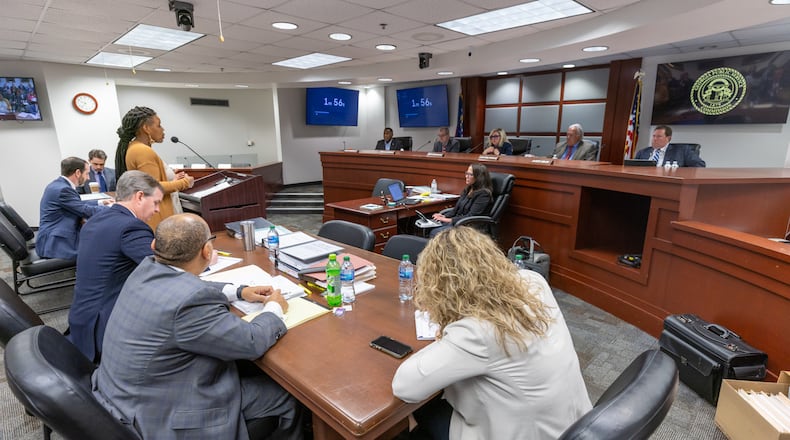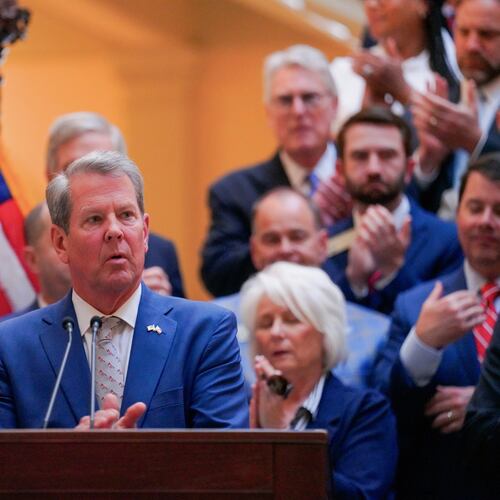Editor’s note: This story has been updated since it was first published to clarify how profits above the top end of Georgia Power’s approved earnings band will be shared amongst the company and its customers.
In a 4-1 vote Tuesday, state regulators at the Georgia Public Service Commission (PSC) approved a plan that will allow Georgia Power to raise rates and collect roughly $1.8 billion more from its customers through 2025.
The vote, the culmination of months of hearings, will affect not just how much the company’s 2.7 million customers pay for electricity over the next three years, but also the future of rooftop solar in Georgia.
Starting in the New Year, the average Georgia Power customer will now pay roughly $4 a month more for electricity. Larger, additional rate hikes of 4.5% will take effect in both 2024 and 2025, but commission staff said Tuesday that an exact dollar amount associated with those increases is not yet known.
Commission Chairman Tricia Pridemore, Vice Chairman Tim Echols, and Commissioners Jason Shaw and Fitz Johnson all voted for the plan, with Commissioner Lauren “Bubba” McDonald the lone “no” vote.
Credit: Elijah Nouvelage
Credit: Elijah Nouvelage
The approved rates will cost customers less than Georgia Power’s initial proposal, which would have raised rates by $2.9 billion over three years. It also reduces the rate increases that will kick in on Jan. 1 by roughly $11, down from the nearly $15 increase on the average monthly bill the company had proposed in the first year of the plan.
Still, it is more than three times larger than what PSC staff had argued was necessary to maintain reliability and keep the company on solid financial footing.
In a statement, Georgia Power’s president, CEO and chairman Chris Womack praised the commission’s decision.
“Since the start of the rate request process, we asked the PSC to set rates at a level that supports the essential, critical investments needed to meet our state’s evolving energy needs,” Womack said. “Today’s decision does that while also balancing affordability needs for customers.”
In the end, the plan the commission approved is similar to what was outlined in a deal struck between Georgia Power, PSC staff and some outside parties last week. However, the five elected commissioners did make decisions Tuesday on a few important items, which the company and staff had failed to reach agreement on.
On Tuesday, a motion by Chairman Pridemore passed 4 to 1 to drop by a hair — from 12% to 11.9% — the top end of the earnings band that dictates how much profit the company can keep, with McDonald voting against the move.
On a quarterly earnings call in October, Georgia Power’s parent, Southern Company, said its profits this year were up nearly $1 billion compared to 2021. Still, Pridemore said she opposed any further reduction because “... In the current environment of increasing interest rates and record inflation, it is important to hold the company close to current band levels in order to maintain the company’s financial integrity and efficiency incentives to ultimately benefit customers.”
Georgia Power also won approval to keep its earnings target at 10.5%, a full 1% above the national average for similar electric utilities.
McDonald proposed several amendments that would have reduced the company’s profits, but all of those failed to pass. The commissioners did unanimously approve a measure shifting the share of earnings above 12% that Georgia Power must refund to its customers from the 10% in the earlier deal between the company and PSC staff to 40%. The motion also reduced the portion Georgia Power can use to pay down asset liabilities — which it earns interest on — from 70% to 40%, while keeping the company’s cut of profits at 20%.
In addition to maintaining its handsome share of profits, Georgia Power succeeded in its fight to keep a popular rooftop solar “net metering” pilot program from expanding. The program, which was created by the PSC in 2019, allows customers with solar panels installed on their roofs to be credited for extra electricity sent back to the grid at a higher rate, allowing households to dramatically lower their bills. But the pilot was capped at 5,000 participants and has been full since the summer of 2021.
Georgia Power has claimed net metering participants reap the benefits of being connected to the company’s grid without paying to maintain it.
On Tuesday, commissioners left the existing cap in place, but increased the amount the company must credit other rooftop solar customers for their excess energy by 4 cents per kilowatt hour.
Environmental groups and solar advocates were disappointed by the commission’s decision.
“Customers need more options to control escalating costs, like access to rooftop solar,” said Jill Kysor, a Solar Initiative leader and senior attorney at the Southern Environmental Law Center. “By failing to expand the net metering program, the commission missed an opportunity to let folks lower bills and to create new local Georgia jobs.”
While Georgia ranks among the top 10 states for total solar capacity, most of that is in the form of massive panel arrays, like those operated by Georgia Power or its contractors. But when it comes to solar panels installed on the roofs of residences, several witnesses in the hearings testified that Georgia ranks in the 40s.
Solar proponents said the state is likely to stay there after the commission’s decision.
“Frustratingly, the PSC’s failure to expand the pilot program and only offer a temporary increase for exported energy will keep the state’s rooftop solar sector mired at the bottom of the national rankings,” said Kevin Lucas, senior director of utility regulation and policy for the Solar Energy Industries Association.
This rate increase in not the last one customers are likely to see in the coming months and years.
Early next year, Georgia Power is expected to file a request to raise rates to cover the cost of coal and gas it has burned at its power plants. Then there are the billions spent on the two new nuclear reactors at Plant Vogtle, which are more than five years behind schedule.
If fuel is loaded into the second of the two units as expected next summer, the company could ask the PSC to begin reviewing whether it can collect “prudently” incurred costs from customers.
Combined with the rate increase approved Tuesday, PSC staff have estimated the fuel and Vogtle costs could drive the average customer’s monthly bill up by $55 to $60 compared to current levels.
What to know about Georgia Power’s new rate plan
- The average household will see their power bills rise by almost $4 a month starting next year.
- Larger, additional rate hikes of 4.5% will take effect in both 2024 and 2025.
- The company mostly maintained its earnings structure, but will have to share more of its profits with customers.
About the Author
Keep Reading
The Latest
Featured





